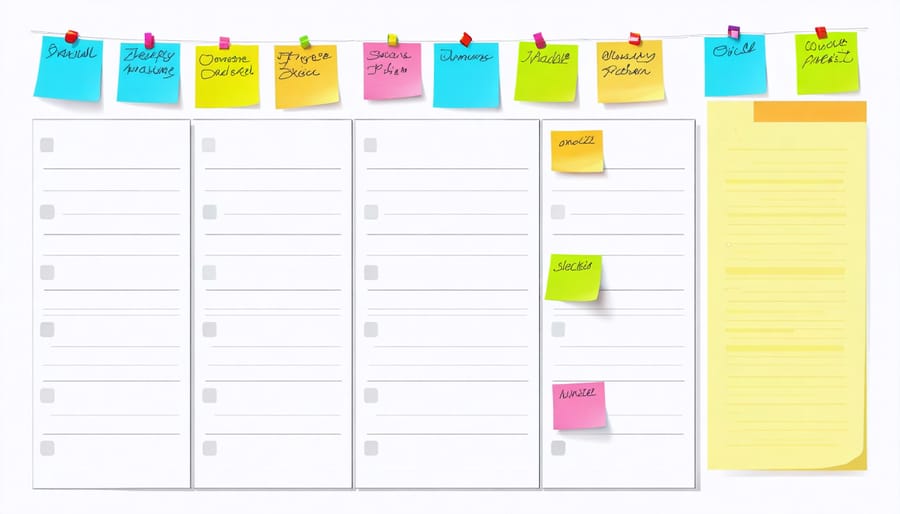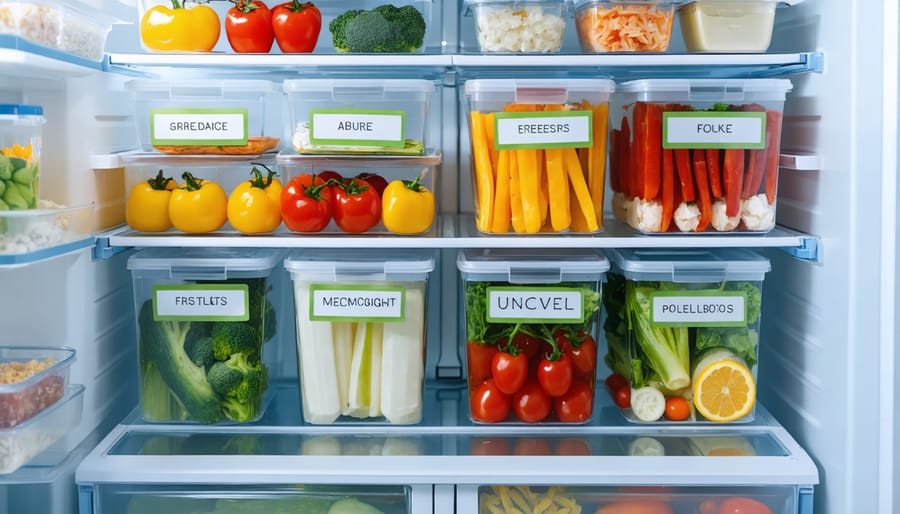
Transform your family’s health and sanity with a meal planning system that actually works. Gone are the days of 5 PM panic and endless takeout orders – strategic meal planning saves you money, reduces stress, and puts nourishing food on the table every single day. As a busy mom who’s mastered the art of efficient meal prep while juggling work and family life, I can tell you that the secret lies in simple, repeatable systems rather than complicated diet rules.
Think of meal planning as your weekly roadmap to success – one that ensures your family gets the nutrition they need while keeping your budget and schedule intact. By dedicating just 30 minutes each weekend to planning, you’ll save hours of weekday stress and hundreds of dollars in impulsive food purchases. Whether you’re feeding picky toddlers or hungry teenagers, a well-structured meal plan helps you navigate dietary preferences, handle busy schedules, and maintain balanced nutrition without losing your mind.
Ready to revolutionize your family’s eating habits? Let’s dive into practical strategies that make meal planning feel less like a chore and more like your secret weapon for household harmony. These tried-and-tested approaches work for real families with real constraints – because perfect meal plans aren’t the goal; sustainable, healthy habits are.
Why Most Family Meal Plans Fail (And How to Fix It)
The Reality of Busy Family Schedules
Let’s be honest – managing a busy family life feels like juggling flaming torches while riding a unicycle. Between school drop-offs, after-school activities, work commitments, and household responsibilities, finding time to plan and prepare nutritious meals can seem almost impossible.
I remember one particularly chaotic Wednesday when my daughter had dance class, my son had soccer practice, and I had a late meeting. The thought of cooking dinner felt overwhelming, and the drive-thru was calling my name. Sound familiar?
Many of us face similar challenges: morning rushes that leave no time for breakfast prep, scattered dinner times due to various activities, and the constant pressure to provide healthy meals despite time constraints. The good news? You’re not alone, and there are ways to make it work.
Understanding these real-world time pressures is the first step toward creating a sustainable meal planning strategy. It’s not about achieving perfection; it’s about finding solutions that work for your unique family schedule and maintaining balance in the midst of chaos.
Building Flexibility Into Your Plan
Let’s be honest – even the best-laid meal plans can go sideways when life throws us a curveball! I learned this lesson the hard way when my perfectly planned week fell apart after a surprise visit from my in-laws. Now, I always build flexibility into my meal planning, and it’s been a game-changer.
Start by designating a few “swing meals” – simple recipes that can work with various ingredients you have on hand. Keep your pantry stocked with versatile staples like quinoa, canned beans, and frozen vegetables that can easily substitute for fresh ones when needed.
Consider planning one or two “leftover remix” nights where you can creatively transform previous meals into something new. For example, Monday’s grilled chicken can become Wednesday’s chicken fajitas or Friday’s chicken salad.
Remember to keep a few emergency meals in your freezer for those hectic days when cooking just isn’t happening. And don’t forget to give yourself grace – sometimes ordering takeout or having breakfast for dinner is exactly what your family needs. The key is finding balance between structure and flexibility that works for your lifestyle.

Creating Your Family’s Nutrition Framework
Balance Over Perfection
Let’s be honest – we’ve all had those weeks where our perfectly planned meals went sideways because life happened. I remember planning an elaborate quinoa Buddha bowl, only to end up making grilled cheese sandwiches because my toddler was having a meltdown. And you know what? That’s completely okay!
The key to sustainable meal planning isn’t perfection – it’s finding your own version of balance. Instead of beating yourself up over not meeting every nutritional benchmark every single day, think about balance over a week. Had a pizza night? Balance it out with a veggie-packed stir-fry the next day.
I’ve learned that the 80/20 approach works wonders: aim to make nutritious choices 80% of the time, and give yourself grace for the other 20%. Keep your pantry stocked with versatile basics like whole grains, legumes, and frozen vegetables. These become your backup dancers when the main show doesn’t go as planned.
Remember, stress around food choices can be more harmful than occasionally straying from your meal plan. Focus on progress, not perfection. If you managed to prep just one healthy breakfast this week when you usually grab fast food – that’s a win! The goal isn’t to become a nutrition expert; it’s to make choices that energize you and fit your real life.
Making Room for Everyone’s Preferences
Juggling different dietary preferences in one household can feel like orchestrating a small restaurant, but it’s one of those essential parenting skills that makes family meals work. I learned this firsthand when my daughter became vegetarian while my son remained a devoted meat-lover!
Start by creating a “common ground” list of ingredients everyone enjoys. For instance, if you’re serving tacos, set up a build-your-own station with both plant-based and meat proteins, plenty of fresh toppings, and various shells. This way, everyone feels considered and can customize their meal.
Keep a running list of “everyone wins” recipes – meals that can be easily modified to suit different needs. Think grain bowls, stir-fries, or pasta dishes where proteins can be added separately. When meal planning, aim for at least 3-4 of these flexible meals each week.
Consider batch cooking components rather than complete meals. Roast various vegetables, prepare different proteins, and cook versatile grains that can be mixed and matched throughout the week. This approach ensures everyone’s nutritional needs are met while maintaining the joy of sharing meals together.
Remember, accommodating different preferences isn’t about cooking multiple separate meals – it’s about finding creative ways to bring everyone to the same table while honoring their choices.
Smart Shopping Strategies That Save Time and Money
The Monthly Master List
I remember when I first started meal planning, my shopping lists were scattered across multiple sticky notes and phone notes. What a game-changer it was when I finally created my Monthly Master List! This comprehensive inventory system has saved me countless hours and reduced those frustrating “I forgot to buy…” moments.
Start by creating a digital or physical template that lists all your regular purchases. Break it down into categories like proteins, produce, pantry staples, and household items. Include quantities you typically need for a month and note which items you buy weekly versus monthly.
Keep track of your family’s favorite meals and their ingredients, marking staples that you always want to have on hand. I keep mine in a simple spreadsheet, but a notes app or paper planner works just as well. The key is consistency in updating and maintaining your list.
Pro tip: Add a “running low” section where family members can jot down items as they use them. This prevents those last-minute realizations that you’re out of essential ingredients. Review and adjust your master list seasonally – your shopping needs in summer will likely differ from winter.
Remember, your master list should be a living document that evolves with your family’s changing tastes and needs.
Seasonal Shopping Secrets
Smart shopping for seasonal ingredients isn’t just good for your wallet – it’s a cornerstone of sustainable family living and nutritious meal planning. I’ve learned that knowing when specific fruits and vegetables are in season can slash grocery bills while ensuring the freshest ingredients land on your table.
Create a seasonal shopping calendar by noting which items are abundant each month. For example, load up on berries and stone fruits in summer, root vegetables and squashes in fall, and citrus fruits in winter. Many grocery stores display seasonal produce prominently and at lower prices – that’s your cue to stock up!
Local farmers’ markets are treasure troves for seasonal finds. I love visiting during the last hour when vendors often offer discounts to clear their inventory. Another money-saving tip: build relationships with local farmers. Many offer bulk discounts or alert regular customers about upcoming deals.
Don’t overlook frozen options for out-of-season produce. Fruits and vegetables are typically frozen at peak ripeness, retaining most nutrients while costing significantly less than their fresh counterparts during off-seasons. This strategy helps maintain nutritious meals year-round without breaking the bank.
From Plan to Plate: Making It Happen
Prep Day Success
Let me share a game-changing discovery from my own meal planning journey: dedicating just 2-3 hours on Sunday afternoon to prep work has revolutionized my entire week. Trust me, this investment pays off tremendously!
Start by creating your prep day routine. I like to begin with washing and chopping all vegetables for the week’s meals. Store them in clear containers, making it easy to grab what you need. Next, batch cook versatile proteins like grilled chicken breast, hard-boiled eggs, or seasoned ground turkey – these become building blocks for various meals.
Make-ahead elements are your secret weapon. Prepare bases like quinoa, brown rice, or roasted vegetables that can be mixed and matched throughout the week. I always make a large batch of homemade salad dressing and prepare mason jar salads for quick lunches.
Pro tip: Use the “assembly line” approach. Instead of completing one task at a time, group similar activities together. For example, chop all vegetables at once, then move on to cooking all proteins, and finally portion everything into containers.
Don’t forget to label everything with dates and contents. This simple step prevents the dreaded “mystery container” syndrome and helps track freshness. Keep your prepped ingredients visible in the fridge – you’re more likely to use what you can see!
Remember, prep day success isn’t about perfection; it’s about progress. Start small and gradually build your routine as you discover what works best for your lifestyle.

Quick-Switch Meals
Let’s be honest – even the best-laid meal plans can go sideways when life gets hectic. That’s why I always keep a few “quick-switch” meals in my back pocket, and I encourage my community to do the same. These are meals you can whip up in 20 minutes or less using pantry staples and minimal fresh ingredients.
My go-to quick switches include a 10-minute Mediterranean chickpea salad (just drain, rinse, and add some olive oil and veggies), or a lightning-fast stir-fry using frozen vegetables and pre-cooked rice. Another lifesaver is breakfast for dinner – scrambled eggs with toast and whatever vegetables you have on hand always hits the spot!
The key is to stock your pantry with versatile ingredients that can transform into quick meals. Think canned beans, whole grain pasta, eggs, and frozen vegetables. I keep a list of five quick-switch meals on my fridge, complete with ingredients needed, so I never have to think twice when plans change.
Remember, switching to a backup meal isn’t failing at meal planning – it’s actually smart planning in action! These flexible options help you stay on track with healthy eating even when life throws you a curveball.

Getting the Family Involved
Making meal planning a family affair can transform it from a tedious chore into an engaging activity that strengthens bonds and teaches valuable life skills. Start by scheduling weekly “menu meetings” where everyone gets a voice in the planning process. Even young children can participate by choosing between healthy options or suggesting their favorite fruits and vegetables.
Consider assigning age-appropriate tasks to each family member. Little ones can help with simple tasks like washing vegetables or setting the table, while older kids might enjoy learning basic cooking techniques or creating their own balanced meals. These shared responsibilities not only lighten your workload but also help develop important life skills and nutritional awareness.
Using effective family communication strategies during meal planning can make the process smoother and more enjoyable. Create a rotating system where each family member gets to be “Chef of the Week,” responsible for planning one meal with your guidance. This builds confidence and creates excitement around healthy eating.
Make it fun by turning grocery shopping into a scavenger hunt, challenging kids to find specific ingredients or teaching them to read nutrition labels. Consider starting a small herb garden together – it’s a wonderful way to connect with food sources while nurturing responsibility and environmental awareness.
As we wrap up our meal planning journey together, I hope you’re feeling inspired and empowered to take control of your family’s nutrition. Remember, you don’t have to transform your entire routine overnight – start small, perhaps with planning just three dinners a week, and build from there. I started my own meal planning journey five years ago, and while it wasn’t perfect at first (my family still jokes about that infamous “experimental” quinoa casserole), it has become second nature now.
The beauty of meal planning lies in its flexibility. Whether you’re focused on improving nutrition, saving money, reducing food waste, or simply making weeknight dinners less stressful, there’s a meal planning approach that will work for you. The key is to find your rhythm and stick with it.
Take what you’ve learned about batch cooking, smart grocery shopping, and balanced nutrition, and adapt it to fit your lifestyle. Don’t be afraid to experiment, adjust, and even fail sometimes – it’s all part of the process. Remember that even the most experienced meal planners have weeks where things don’t go as planned, and that’s perfectly okay.
I encourage you to start your meal planning adventure this week. Take that first step – whether it’s creating a simple weekly menu or prepping some vegetables for the days ahead. Your future self will thank you for the time, money, and stress you’ll save.



